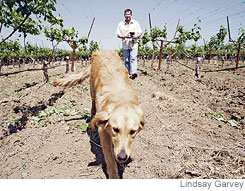
This is Golden Ros sniffing mealybug pheromones on a Napa Valley grapevine. We love seeing our Goldens using their intelligent sniffers to help in our lives. This is just one of the applications in scent detection. You can learn about many more working fields related to the olfactory sense at my “Sniffers” page at the foundation site. Just remember, to our dogs, the whole world is a smell.
And, to see a cool video of Golden Ros and her buddies on the job, just click here where you can also learn more about Agriculture Detection Dogs.
Dogs With a Nose For Mealybugs Go To Work in Napa – Challenge Is to Sniff Out Pests Ruining the Grapes; Ros Passes the Smell Test
By JIM CARLTON, Wall Street Journal
RUTHERFORD, Calif. — On a recent afternoon here at the Honig Vineyard and Winery, dog trainer Edwina Ryska wandered through a tangle of grapevines with her golden retriever Ros. “Go search!” Ms. Ryska told the year-old pup.
Ros bounded off, her nose in the air, looking for bugs hoping to mate.
Love is in the air in Napa, and it’s Ros’s job to sniff it out. With her siblings — Rigo, Richardson and Rousek — she was bred and trained to use a special new talent to find vine mealybugs that are having sex.
Mealybugs — cream-colored, oval-shaped critters so small that dozens can fit in a square inch — have become a big problem for the California wine industry. The rapidly reproducing insects, often accompanied by an army of ants to protect them, feed on vines and ruin grapes by leaving heavy excretions of mold-forming honeydew. Over the past 13 years, the bugs have spread north from Southern California into the Napa-Sonoma wine country, forcing vintners to spend as much as $30 million a year trying to eradicate them. But the bugs are notoriously difficult to pin down; hundreds cram together to hide under bark and roots.
That makes dogs like Ros a potentially important new weapon in the fight to protect vineyard grapes. Trained to detect the scent of female mealybugs in heat, the dogs point and bark when they smell mealybugs on a grapevine. Workers can then cut away the infected vine limb before it contaminates the rest of the crop.
“It’s one of those cool ideas in science that if it takes off, it would be fantastic,” says Kent Daane, an agriculture researcher for the University of California at Berkeley.
The dogs aren’t proven bug sleuths yet. Ros and her siblings were bred only last year as part of an ambitious experiment for Honig and some other local Napa wineries. The pups will need at least another year to be fully field-worthy, their handlers say. The test “has a long way to go,” says Mr. Daane.
Still, the dogs intrigue many in wine country because mealybugs are such a tenacious foe. Once the bugs’ telltale honeydew can be seen on the grapes, whole sections of a vineyard have often been infested. Between 30,000 and 40,000 acres of California grapes are currently infested with vine mealybugs first discovered in the state in 1994, with annual damages of $3 million to $5 million, state officials estimate. Researchers hypothesize that the bug entered the U.S. illegally on some Israeli vine cuttings in the early 1990s and then started spreading.
“It’s like the war on terror,” says Ross Smith, a pest-control adviser in Napa Valley. “These guys are trying to attack our way of life, and we need to find and neutralize them.”
In early 2005, Michael Honig, president of the family-owned Honig Vineyard, and a group of local vintners concluded that early detection was key and decided to train dogs to sniff out the bugs. Theorizing that a dog’s keen sense of smell could work as well as insecticides without causing any of the environmental fallout, they contacted the nearby Assistance Dog Institute in Santa Rosa, which trains companion dogs for paraplegics and other disabled people.
“We knew about dogs being able to sniff out drugs and bombs, so we wondered if they could be trained to sniff out a vineyard pest,” says Mr. Honig, 45 years old, whose family has owned his 70-acre vineyard since 1964. While mealybugs haven’t attacked his property, Mr. Honig says, “We wanted to be proactive.” He and some other vintners contributed about $50,000 to pay for testing the theory.
At the institute, workers began exposing a litter of seven-week-old golden retriever pups in late 2005 to a synthetic version of the mealybug smell. Mr. Honig says retrievers were chosen because the breed does well working with humans as guide dogs and in other capacities. “Theirs is the best breed for detective work,” he says.
To help brand the odor in the dogs’ memory, the female mealybugs’ pheromones were planted in bowls of dog food. Because the smell is too faint for the human nose to detect, nobody was certain the puppies would be able to smell the mealybugs.
